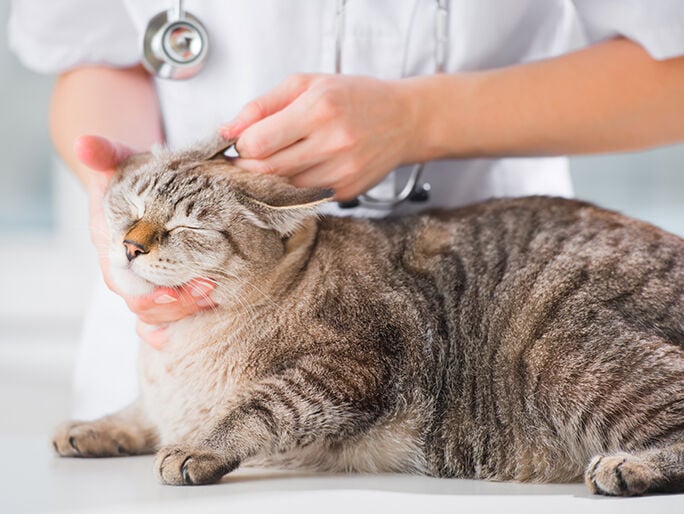sarcoptic mange in dogs and cats
Sarcoptic mange (also called scabies) is caused by a highly contagious parasite that can be passed from pets to people and from people to pets.
Also called feline or canine scabies, sarcoptic mange causes unbearable itchiness that can lead to advanced skin infections in pets. This tiny mite can easily spread to other pets and people.

Clinical signs of sarcoptic mange in pets
- Intense itching, scratching, and chewing on skin
- Injuries from itching, scratching, and chewing
- Bald, crusty, and swollen skin
- Secondary bacterial skin infections
Treating sarcoptic mange in dogs and cats
- Avoid home “remedies”
- Consult your veterinary team
- Follow all veterinary directions
- Complete all medications and treatments

Help prevent sarcoptic mange in people and pets
- Consult your veterinary team
- Keep unaffected pets separate
- Treat all pets in the household
- Contact your family doctor if you have any human health concerns
The lowdown on sarcoptic mange
There are two types of mange. Like demodectic mange, sarcoptic mange is a skin disease caused by mites. But unlike the Demodex mite, the scabies mite that causes sarcoptic mange can infect both pets and people.

Just the basics
Sarcoptic mange is an inflammatory skin disease caused by the scabies mite, Sarcoptes scabiei, which can infect both people and pets. The disease is often seen in dogs and is very rare in cats.
Sarcoptic mites, which can’t be seen with the naked eye, cause intense inflammation and itchiness by burrowing into skin to feed and lay eggs. Even a few scabies mites can cause your dog to literally scratch themselves raw.
As the disease progresses to larger patches of skin, dogs may lose most or all of their hair. They may also have large oozing and crusty patches due to infection from constant scratching and irritation.
What causes scabies?
Scabies is incredibly contagious through contact with infected pets and people, sheets and other fabrics, and grooming tools. While dogs are the scabies mite’s natural host, they will also infect people and, rarely, cats.
Wild dogs like foxes or wolves can also carry scabies, so keeping your dog from exploring areas with known wild dog populations can be helpful in preventing an infestation.
The clinical signs of sarcoptic mange
The main symptom of sarcoptic mange in pets is persistent scratching and chewing at their skin, which then leads to secondary skin issues and inflammation.
- Relentless itching: Scabies mites create a nonstop burning itch that is deeply unpleasant for both pets and people.
- Sores and baldness: Inflammation from mites, plus injuries from scratching, can cause baldness and lead to skin sores and infections. If left untreated, a scabies infection in dogs can cause complex skin damage over time.
Humans and mange
The scabies mite is a zoonotic parasite that affects both pets and people. Humans and dogs can easily infect and reinfect each other.
If your pet has been diagnosed with scabies, follow all veterinary instructions carefully to avoid spreading the disease. Treat all pets in the household until your veterinary team confirms they are no longer contagious, and regularly wash all tools and bedding carefully as directed.
As these mites can also cause severe itching in people, any concerns regarding you or your human family members should be discussed with your doctor.
Don’t let sarcoptic mange go untreated!
Sarcoptic mange is a miserable condition that causes unbearable itchiness. If left untreated, scabies can spread over your pet’s entire body and lead to advanced skin disease that requires intensive veterinary care.
Mange isn’t just unsightly; it’s also contagious. Infected pets can pass scabies mites to other pets and people, leading to additional disease. So it’s a good idea to act as soon as you suspect a skin problem.
Your pet’s body cannot deal with the scabies mite on its own. Please seek veterinary care.
Say “no” to natural remedies
You may be tempted to use natural remedies or home cures like apple cider vinegar, honey, or neem-based shampoos on your pet. Be aware that none of these substances have been scientifically tested to be effective in treating scabies.
If you think your pet has sarcoptic mange, please consult with your veterinary team. Even if medical skin scrapings don’t show scabies mites (they are difficult to find in skin samples), your veterinarian can provide a plan to begin treating any suspected mites and manage the itch.
Sarcoptic mange may need multiple medications to manage the itch and wounds. Many of the flea products your veterinarian carries can also treat scabies, but may need special dosing.
Tips to avoid sarcoptic mange
You can help pets (and people) avoid scabies with good home hygiene and regular supportive wellness care.
Veterinary wellness care:
Regular vet visits can help your veterinary team to evaluate early signs and take action.
Good home hygiene:
Groom your pet to help you stay on top of their general skin and coat health, and regularly wash all pet bedding and grooming tools.
Help keep your pet safe:
Avoid letting your pet roam in areas with wild animals that may spread scabies and other diseases.
Mentioned in this article




Need advice on flea control? Ping Pet Chat™!
Whether it's 3 a.m. or 3 p.m., connect with a real veterinary professional for immediate petcare advice. It's included in all Optimum Wellness Plans®!
Log in to start chatting
Save at the Banfield Shop
Our mission is to provide high-quality prescription meds for the pet you love. We believe in safe, effective petcare, so we thoroughly assess every item we carry. We offer discounts on eligible products with your pet’s Optimum Wellness Plan. And you can easily schedule deliveries with our super convenient AutoShip program.
Banfield can help prevent and treat parasites in pets

Regular wellness exams that include a full physical and fecal exam can help keep your furball happy and healthy. Kittens and puppies should start regular appointments when they’re about 6 weeks old, and then come in twice a year once they’re 5 months old. At your visits, we’ll check your little love from nose to tail, discuss age, needs, and lifestyle, and recommend trusted prevention medication to help fight off nasty critters that might feed on your pet.
Even if your pet is on a regular preventive for fleas, ticks, worms, mange, and other bugs, please make an appointment as soon as possible if you spot potential symptoms. Sooner is always better in helping to prevent a big infestation for your furry friend.
 Podcast - Not Just Fluff
Podcast - Not Just Fluff



